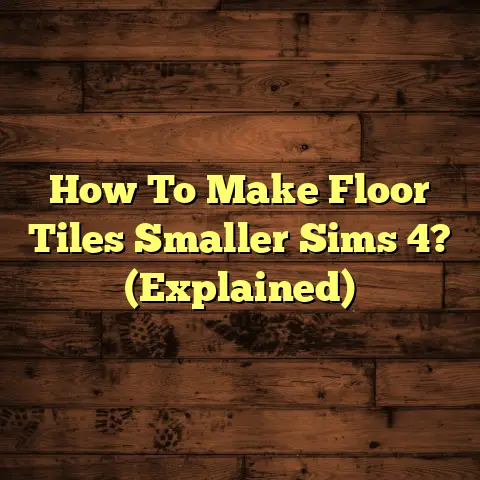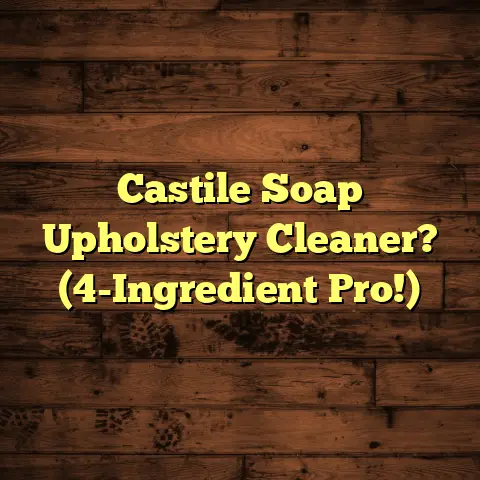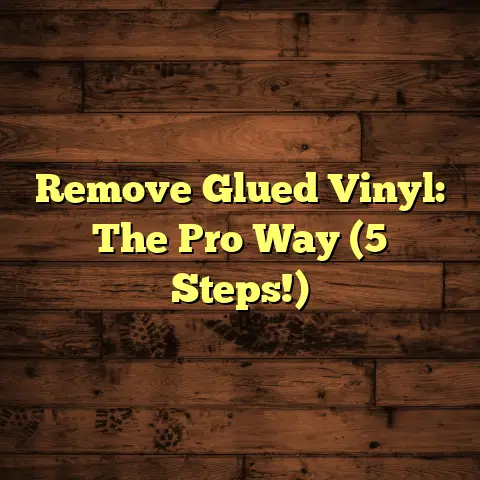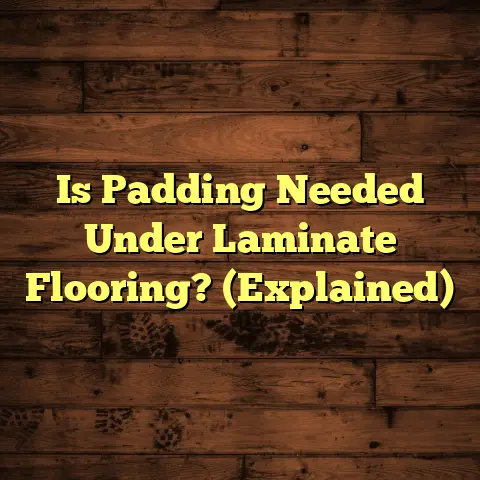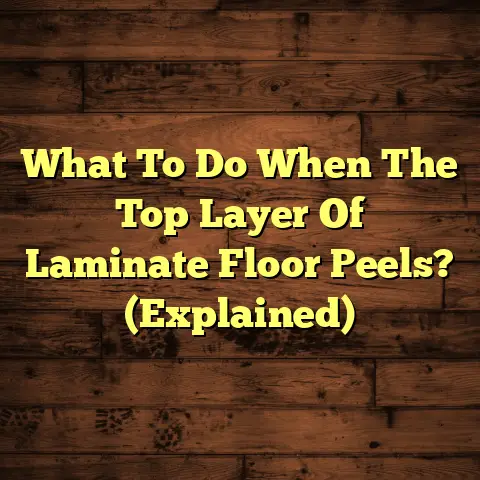How To Fix Concrete Garage Floor? (in 4 Hours!)
(In 4 Hours!)
Ever glance at your garage floor and think, “Ugh, I really need to do something about that”?You’re not alone. Concrete garage floors are like the unsung heroes of our homes. We take them for granted, parking cars, storing tools, and sometimes, well, completely abusing them.
But what if I told you that fixing those cracks, stains, and uneven spots doesn’t have to be a massive, wallet-draining project?
What if you could actually transform your garage floor in just four hours? Sounds crazy, right?
Well, it’s not! I’m going to let you in on a little secret: with the right DIY techniques and tools, you can achieve a professional-looking finish without breaking the bank or spending an entire weekend on it.
I’m excited to share these tips with you. Let’s get started and take control of your garage space!
Section 1: Understanding Common Issues
with Concrete Garage Floors
1.1 Overview of Concrete Garage Floors
Concrete is super popular for garage floors, and for good reason. It’s tough, durable, and can handle a lot of weight. I’ve seen concrete floors last for decades!
But even the toughest concrete isn’t immune to the wear and tear of daily life. Over time, all sorts of problems can pop up.
Think of it like this: your garage floor is constantly battling against the elements, heavy vehicles, spilled fluids, and just general use.
It’s bound to show some signs of stress eventually.
1.2 Common Problems
Let’s dive into some of the most common issues I see with concrete garage floors:
-
Cracks (hairline and wide): These are probably the most frequent complaint. Hairline cracks are thin and often harmless, but wider cracks can be a sign of more serious structural issues.
They can also let moisture in, which can lead to further damage. I always tell my clients to address cracks as soon as they see them. * Stains from oil, grease, and chemicals: Ah, the dreaded oil stain! These are almost inevitable in a garage. Oil, grease, and other chemicals can penetrate the concrete, leaving unsightly stains that are tough to remove.
I once had a client who spilled an entire gallon of motor oil on their garage floor. It took a lot of elbow grease (pun intended!) to get that cleaned up. * Spalling and flaking: This is when the surface of the concrete starts to break down, leaving behind a rough, uneven texture. It’s often caused by moisture and freeze-thaw cycles.
I’ve seen spalling get so bad that it creates potholes in the garage floor. Definitely something you want to avoid! * Uneven surfaces and settling: Over time, the ground beneath your garage floor can shift, causing the concrete to settle unevenly. This can create dips, bumps, and slopes that can be annoying and even dangerous.
I remember one garage where the floor sloped so much that the car would roll out on its own if you didn’t set the parking brake!
To give you a better picture, here’s a table showing the causes and potential fixes for these common issues:
| Issue | Cause | Potential Fix |
|---|---|---|
| Hairline Cracks | Normal settling, minor stress | Concrete filler, sealant |
| Wide Cracks | Structural issues, significant stress | Patching compound, crack injection |
| Oil/Grease Stains | Spills, leaks | Degreasers, concrete stain remover, sealant |
| Spalling/Flaking | Moisture, freeze-thaw cycles | Concrete resurfacer, patching compound |
| Uneven Surfaces | Settling, soil erosion | Concrete resurfacer, self-leveling compound |
Visual Aid: Imagine a picture here showing each of these problems. It’s always easier to understand when you can see it!
Section 2: Preparing for the Fix
2.1 Tools and Materials Needed
Okay, now that we know what we’re up against, let’s talk about the tools and materials you’ll need to get the job done. Here’s a list of essentials:
- Concrete patching compound: This is your go-to for filling in cracks and small holes. I recommend a high-quality, polymer-modified compound for the best results.
- Epoxy or sealant for stains: For oil and grease stains, you’ll need a good degreaser and a concrete sealant to prevent future stains. Epoxy coatings are also a great option for a more durable, stain-resistant finish.
- Concrete resurfacer: If your floor is severely damaged or uneven, you might need to resurface the entire thing. This involves applying a thin layer of concrete mix over the existing surface.
- Trowel, scraper, and broom: These are essential for applying and smoothing out the patching compound and resurfacer. A good scraper will also help you remove loose debris and old sealant.
- Safety gear (gloves, goggles, mask): Safety first! Always wear gloves, goggles, and a mask when working with concrete and chemicals. Concrete dust can be irritating to your skin and lungs.
Here’s a more detailed list of tools and materials, along with some of my favorite brands:
| Tool/Material | Brand Recommendation | Why I Like It |
|---|---|---|
| Concrete Patching Compound | Quikrete Advanced Formula | Durable, easy to apply |
| Concrete Degreaser | Krud Kutter Concrete | Effective on tough oil stains |
| Concrete Resurfacer | Ardex Feather Finish | Smooth finish, easy to work with |
| Trowel | Marshalltown | High-quality, comfortable grip |
| Safety Goggles | 3M Safety Goggles | Comfortable, anti-fog |
| Dust Mask | 3M N95 Respirator | Protects against concrete dust |
2.2 Safety Precautions
Before you start tearing into your garage floor, let’s talk safety. Concrete work can be messy and potentially hazardous if you don’t take the right precautions.
- Ventilation: Concrete dust and chemical fumes can be harmful if inhaled. Make sure your garage is well-ventilated by opening doors and windows.
- Protective Gear: As I mentioned before, always wear gloves, goggles, and a mask. Concrete can irritate your skin, and dust can damage your lungs.
- Read the Labels: Always read and follow the manufacturer’s instructions for all the products you’re using. This will help you avoid accidents and ensure that you’re using the products correctly.
- Be Aware of Surroundings: Keep children and pets away from the work area. You don’t want them getting into the concrete or chemicals.
I once saw a guy who didn’t wear gloves while working with concrete. His hands were red and cracked for weeks! Trust me, it’s not worth the discomfort.
Section 3: Step-by-Step Guide to Fixing
Your Concrete Garage Floor
3.1 Assessing the Damage
Alright, it’s time to get down to business! The first step is to carefully assess the damage to your garage floor.
Take a good look at the cracks, stains, and uneven spots. How big are the cracks? How deep are the stains? Is the floor just a little uneven, or is it a major slope?
The answers to these questions will help you determine the best repair method. For example, if you only have a few hairline cracks, you can probably get away with just filling them with a concrete filler.
But if you have wide cracks or a severely damaged surface, you might need to do some more extensive repairs, like resurfacing.
Here’s a quick guide to help you assess the damage:
- Hairline Cracks: Less than 1/8 inch wide.
- Wide Cracks: 1/8 inch wide or wider.
- Stains: Light, moderate, or severe.
- Unevenness: Slight (less than 1/4 inch), moderate (1/4 to 1/2 inch), or severe (more than 1/2 inch).
3.2 Cleaning the Garage Floor
Before you can start repairing anything, you need to clean the garage floor. This will remove any debris, oil, and dust that could interfere with the repair process.
- Remove Debris: Start by sweeping the floor with a broom to remove any loose dirt, leaves, or other debris.
- Degrease: If you have oil or grease stains, apply a concrete degreaser to the affected areas. Let it sit for the recommended amount of time, then scrub with a stiff brush.
- Pressure Wash (Optional): For a really thorough cleaning, you can use a pressure washer. This will blast away any remaining dirt and grime. Be careful not to damage the concrete with too much pressure.
- Rinse: Rinse the floor with clean water to remove any remaining cleaning agents.
- Dry: Let the floor dry completely before you start any repairs. This could take several hours, depending on the weather.
I always recommend using a pressure washer if you have one. It makes the cleaning process so much faster and more effective. But if you don’t have a pressure washer, a good scrub brush and some elbow grease will do the trick.
3.3 Repairing Cracks
Okay, now we’re ready to tackle those cracks! Here’s a step-by-step guide on how to fill and repair them:
For Hairline Cracks:
- Clean the Crack: Use a wire brush to remove any loose debris from the crack.
- Apply Concrete Filler: Apply a thin layer of concrete filler to the crack, using a putty knife or trowel.
- Smooth the Surface: Smooth out the filler with the trowel, making sure it’s flush with the surrounding concrete.
- Let it Dry: Let the filler dry completely, according to the manufacturer’s instructions. This could take several hours.
For Wider Cracks:
- Widen the Crack: Use a hammer and chisel to widen the crack slightly. This will help the patching compound adhere better.
- Clean the Crack: Use a wire brush and a vacuum cleaner to remove any loose debris from the crack.
- Mix Patching Compound: Mix the patching compound according to the manufacturer’s instructions.
- Apply Patching Compound: Apply the patching compound to the crack, using a trowel.
- Smooth the Surface: Smooth out the patching compound with the trowel, making sure it’s flush with the surrounding concrete.
- Let it Dry: Let the patching compound dry completely, according to the manufacturer’s instructions. This could take 24 hours or more.
I always tell my clients to overfill the crack slightly with the patching compound. This will allow for some shrinkage as the compound dries. Once it’s dry, you can sand it down to make it perfectly flush with the surrounding concrete.
3.4 Addressing Stains
Stains can be a real eyesore, but they’re usually not too difficult to remove. Here’s how to treat different types of stains:
- Oil and Grease Stains:
- Apply Degreaser: Apply a concrete degreaser to the stain.
- Let it Sit: Let the degreaser sit for the recommended amount of time.
- Scrub: Scrub the stain with a stiff brush.
- Rinse: Rinse the area with clean water.
- Repeat: Repeat as necessary until the stain is gone.
- Seal: Apply a concrete sealant to prevent future stains.
- General Stains:
- Apply Stain Remover: Apply a concrete stain remover to the stain.
- Let it Sit: Let the stain remover sit for the recommended amount of time.
- Scrub: Scrub the stain with a stiff brush.
- Rinse: Rinse the area with clean water.
- Repeat: Repeat as necessary until the stain is gone.
For really stubborn stains, you might need to use a poultice. This is a mixture of a stain remover and an absorbent material, like baking soda or diatomaceous earth.
Apply the poultice to the stain, cover it with plastic wrap, and let it sit for 24 hours. Then, remove the plastic wrap and scrape off the poultice.
3.5 Resurfacing the Floor
If your garage floor is severely damaged or uneven, you might need to resurface the entire thing. This is a bigger project than just repairing cracks and stains, but it can make a huge difference in the appearance and functionality of your garage.
- Prepare the Surface: Clean the floor thoroughly, as described in Section 3.2. You might also need to etch the concrete with muriatic acid to help the resurfacer adhere better.
- Mix the Resurfacer: Mix the concrete resurfacer according to the manufacturer’s instructions.
- Apply the Resurfacer: Apply the resurfacer to the floor, using a trowel or squeegee. Work in small sections, and make sure to spread the resurfacer evenly.
- Smooth the Surface: Smooth out the resurfacer with a trowel, creating a flat, even surface.
- Add Texture (Optional): If you want to add some texture to the floor, you can use a broom or a текстурный roller.
- Let it Dry: Let the resurfacer dry completely, according to the manufacturer’s instructions. This could take several days.
I always recommend applying two thin coats of resurfacer rather than one thick coat. This will help prevent cracking and ensure a more durable finish.
Section 4: Final Touches and Maintenance Tips
4.1 Sealing the Floor
Once you’ve repaired and resurfaced your garage floor, it’s important to seal it. This will protect the concrete from future damage and make it easier to clean.
- Clean the Floor: Make sure the floor is clean and dry before you apply the sealer.
- Apply the Sealer: Apply the concrete sealer according to the manufacturer’s instructions. You can use a brush, roller, or sprayer.
- Let it Dry: Let the sealer dry completely before you drive on it. This could take 24 hours or more.
There are two main types of concrete sealers: penetrating sealers and topical sealers. Penetrating sealers soak into the concrete and create a waterproof barrier. Topical sealers form a protective film on the surface of the concrete.
I usually recommend using a penetrating sealer for garage floors. They’re more durable and less likely to peel or flake.
4.2 Maintenance for Longevity
To keep your garage floor in top condition, it’s important to perform regular maintenance. Here are some tips:
- Sweep Regularly: Sweep the floor regularly to remove dirt and debris.
- Clean Spills Immediately: Clean up any spills as soon as they happen to prevent staining.
- Use Mats: Place mats under your car and other equipment to protect the floor from oil and grease.
- Inspect Regularly: Inspect the floor regularly for cracks and other damage. Repair any damage as soon as possible to prevent it from getting worse.
I always tell my clients that a little bit of maintenance goes a long way. By taking care of your garage floor, you can extend its lifespan and keep it looking great for years to come.
Conclusion: Transform Your Garage in Just
Four Hours!
So, there you have it! With the right tools, techniques, and a bit of determination, you can transform your concrete garage floor in just four hours.
I know it might seem like a daunting task, but trust me, it’s totally doable. And the feeling of accomplishment you’ll get from doing it yourself is priceless.
Plus, you’ll save a ton of money by not hiring a professional contractor.
So, what are you waiting for? Get out there and start fixing your garage floor! You’ll be amazed at the difference it makes.
And remember, if you have any questions, don’t hesitate to ask. I’m always happy to help. Now go enjoy your newly transformed garage!
